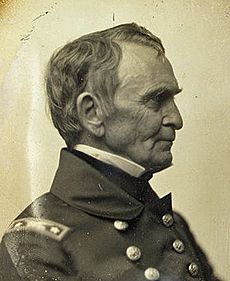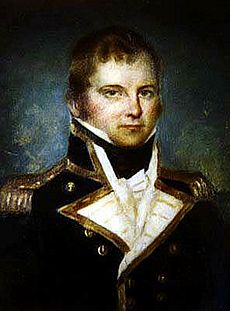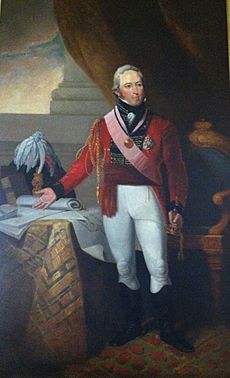Battle of Hampden facts for kids
Quick facts for kids Battle of Hampden |
|||||||
|---|---|---|---|---|---|---|---|
| Part of the War of 1812 | |||||||
|
|||||||
| Belligerents | |||||||
| Commanders and leaders | |||||||
| Robert Barrie John Coape Sherbrooke |
Charles Morris | ||||||
| Strength | |||||||
| 3 warships 2 support ships 750 |
1 warship 725 |
||||||
| Casualties and losses | |||||||
| 2 killed 8 wounded 1 missing |
1 killed 11 wounded prisoners 70 captured 1 frigate scuttled |
||||||
The Battle of Hampden was a fight during the War of 1812. It happened when the British tried to take over what is now Maine. They wanted to make it a new colony called New Ireland. Sir John Sherbrooke led the British forces from Halifax. This new colony only lasted for about eight months. After the war, the British left, and eastern Maine stayed part of the United States. This event made people in Maine want their own state even more. It also marked the end of a long history of different countries fighting over Maine.
Contents
What Led to the Battle?
British Capture Castine
On August 26, 1814, a British fleet from Halifax set out to capture the town of Machias. This fleet included five warships and ten transport ships carrying about 3,000 British soldiers.
The whole mission was commanded by Sir John Sherbrooke. Major General Gerard Gosselin led the army, and Rear Admiral Edward Griffith Colpoys was in charge of the navy.
The British wanted to claim the land east of the Penobscot River as their own, calling it "New Ireland." This area was important for connecting Halifax and Quebec. While on their way, they learned that the American ship USS Adams, commanded by Captain Charles Morris, was being repaired at Hampden. Sherbrooke changed his plan and headed for Castine instead.
On September 1, the British force entered Castine. The local American militia quickly left. A small group of U.S. Army soldiers destroyed their cannons and blew up their gunpowder before also leaving.
Sherbrooke and Griffith told the people of Castine that if they stayed calm and gave up their weapons, they would be safe. They also promised to pay fair prices for goods. Next, British soldiers crossed the bay to occupy Belfast. This protected the side of their main operation. Locals did not fight back, though about 1,200 militiamen gathered nearby.
Journey Up the Penobscot River
Admiral Griffith ordered Captain Robert Barrie of the Royal Navy to go after the Adams. Captain Barrie sailed up the Penobscot River with three warships and two support ships. They carried about 750 soldiers and Royal Marines.
The Battle of Hampden

When Captain Morris brought the Adams into the river, he anchored it at Hampden, about 30 miles inland. He expected an attack. So, he placed nine of his ship's cannons on a nearby hill and fourteen more on the dock next to his damaged ship. Morris, with his crew of 150, asked for help from Brigadier General John Blake, who commanded the local militia. General Blake arrived with about 550 militiamen. They formed a defensive line on a ridge facing south. Lieutenant Lewis and his small group of regulars also joined, setting up their cannons on the right side, covering the road where the British were expected.
Late on September 2, Captain Barrie landed his force a few miles below Hampden. Early on September 3, in the rain and fog, the British moved toward Hampden. They met some resistance at Pitcher's Brook, mainly from Lewis's cannons. But the British pushed forward and crossed the bridge. Soon, they were ready to attack the American line on the hill.
The sight of the organized British soldiers, with their bayonets, scared the untrained militia. The center of the American line broke and ran into the woods. Captain Morris on the left and Lieutenant Lewis on the right were left in a difficult spot. To prevent the British from capturing his ship, Morris destroyed his cannons and set fire to the Adams. The ship exploded before the British could reach it. Lewis also destroyed his cannons and retreated north. Morris and his crew made it to Bangor, then traveled through rough country to Portsmouth, New Hampshire. Every sailor reported back safely, which made Morris very happy.
After the battle, Captain Barrie sent 200 men to take control of Hampden. He and the rest of his force chased the Americans toward Bangor. Many important men from Hampden were held as prisoners overnight but were mostly released the next day.
British Actions in Bangor and Hampden

Captain Barrie, with three of his ships, entered Bangor and demanded that the town surrender completely. He asked for food and places for his men to stay. He warned that if the townspeople didn't cooperate, his men would cause damage. Although Barrie tried to stop his troops from drinking, some found alcohol. This led to some damage to stores and property. Many citizens fled to the woods.
During the night, the British burned 14 vessels across the river in Brewer. To prevent their own town from burning, Bangor's leaders made a deal with Barrie. They offered him a large sum of money and agreed to finish building four ships and deliver them to him in Castine. Barrie accepted this and took some ships with him. Before leaving on September 4, Barrie released 191 local prisoners, including General Blake. Bangor's leaders estimated their losses and damages were very high.
The British then spent more time in Hampden. They caused damage to gardens, furniture, books, and papers. Two ships anchored near the town were burned. The town committee asked Barrie to treat them more kindly. He replied that his job was to "burn, sink, and destroy." He said that by the rules of war, he could burn their houses and harm the people, but he would spare their lives. Barrie did not burn the houses, but he did demand a large sum of money for several unfinished ships in town. The town estimated its total losses were also very high.
The British then moved to Frankfort, demanding livestock and weapons. The locals were slow to obey, and Barrie threatened to return. He did not, and the Battle of Hampden ended.
Who Was Hurt?
The British Army lost 1 soldier killed, 1 officer and 7 soldiers wounded, and 1 soldier missing. The Royal Navy reported 1 sailor killed. Two British graves in Hampden are still there today.
American casualties were low. One militiaman was killed and 11 were wounded. About 84 Americans were taken prisoner. Captain Barrie couldn't give an exact number but noted about 30 wounded in the woods. Militia leaders also had trouble confirming how many men were present.
British Leave Castine
Sherbrooke declared "New Ireland" (Eastern Maine) a British province. General Gosselin was left in Castine to govern it. For the next eight months, the Penobscot River was like a border between countries.
However, the Treaty of Ghent, signed in December 1814, ended the war. This meant the British gave up their claim to Maine. The British left Castine on April 25, 1815, and the old border was put back in place. The final border between Maine and Canada was settled later in 1842 by the Webster-Ashburton Treaty.
What Happened Next?
The memory of this defeat helped create strong anti-British feelings in Eastern Maine. This feeling would show up again in the Aroostook War of 1838-1839. It also helped push Maine to become its own state, as Massachusetts had not protected the region well. This led to the building of a large fort, Fort Knox, at the mouth of the Penobscot River starting in the 1840s.
General Blake and two other officers were put on trial in 1816 for their part in the defeat. Blake was found innocent. He then brought charges against his two subordinates. One officer, Andrew Grant, was found guilty of acting improperly during the battle and was not allowed to be a militia officer again.
|


